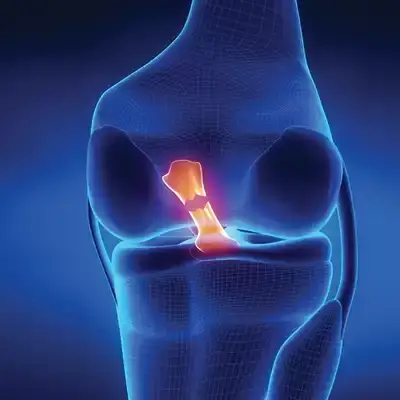You’re mid-sprint on the field, deep in a squat at the gym, or simply pivoting during a weekend basketball game and then it happens. A sharp pain in your knee, maybe a popping sound, followed by swelling and a growing sense of instability. You brush it off. Just a sprain, right?
For many athletes and active adults, this moment marks the beginning of a meniscus tear, a common but often misunderstood knee injury. And while rest, ice, and time might sound like the go-to remedies, they’re not always enough.
In this blog, we explore when a torn meniscus needs more than conservative care, why surgery might be the right step, and how modern techniques make recovery faster and safer than ever before.

What Exactly Is a Meniscus Tear?
The meniscus is a crescent-shaped piece of cartilage that acts as a shock absorber between your thighbone (femur) and shinbone (tibia). Each knee has two: a medial meniscus (inside) and a lateral meniscus (outside). Together, they stabilize the joint and cushion your movements.
Tears occur when the meniscus is twisted or compressed beyond its normal range often during sports that involve cutting, pivoting, or rapid direction changes. Think football, soccer, basketball, skiing, or even intense workouts like CrossFit.
Depending on the nature of the tear, symptoms may include:
- Sudden or delayed knee swelling
- Pain when twisting or rotating the knee
- A catching or locking sensation
- Stiffness or limited range of motion
- A feeling like your knee might “give out”
Why Rest Alone Isn’t Always Enough
The initial instinct after any injury is usually RICE: rest, ice, compression, and elevation. For minor tears or older individuals with low activity levels, this approach can work. But for athletes or those who live an active lifestyle, relying on rest alone may prolong discomfort or make things worse.
Here’s why:
- Limited blood supply: Only the outer third of the meniscus (called the “red zone”) has a good blood supply, which is essential for healing. Tears in the inner “white zone” often don’t heal without intervention.
- Ongoing joint stress: Staying active with a torn meniscus can cause further damage, including worsening the tear or accelerating wear on the cartilage, potentially leading to early-onset osteoarthritis.
- Functional instability: A torn meniscus can affect your balance, strength, and movement coordination posing a serious risk if you’re training or competing.
Signs It’s Time to Consider Surgery
Not every meniscus tear needs surgery. But if you’re an athlete or an active adult and experience any of the following, it’s time to speak with an orthopedic surgeon:
- Pain that persists for more than 6 weeks despite rest
- Swelling that comes and goes but never fully resolves
- Limited range of motion or a locked knee
- Inability to return to sports or active movement
- Tear confirmed on MRI as complex, displaced, or bucket-handle shaped
Surgical treatment becomes especially important when your knee can’t function properly or when long-term damage is a risk. Waiting too long can lead to cartilage degeneration and chronic knee problems.
Types of Meniscus Surgery
Modern meniscus surgery is typically performed arthroscopically meaning small incisions, a camera-guided scope, and minimal disruption to surrounding tissues. Depending on the nature and location of the tear, your surgeon may opt for one of the following:
1. Meniscus Repair
This technique involves stitching the torn edges together. It’s the ideal option for younger patients or athletes when the tear is in the vascular (red) zone. The goal is to preserve as much of the meniscus as possible, since it plays a vital role in joint protection.
- Pros: Preserves knee biomechanics, lowers arthritis risk
- Cons: Longer recovery time, usually 4–6 months before return to full sports
2. Partial Meniscectomy
Here, the damaged portion of the meniscus is trimmed and removed, allowing the healthy part to remain.
- Pros: Faster recovery (typically 4–6 weeks), lower risk of surgical failure
- Cons: Slightly higher risk of long-term joint degeneration
3. Meniscus Transplant (Rare Cases)
For severely damaged knees or multiple failed surgeries, a donor meniscus may be transplanted but this is typically reserved for younger patients with specific indications.
The Road to Recovery
While surgery may sound intimidating, recovery from arthroscopic meniscus procedures is often quicker and more manageable than most people expect, especially with today’s rehabilitation strategies.
Week 1–2: Rest, ice, and begin light range-of-motion exercises. You may need crutches depending on the surgery type.
Week 3–6: Guided physical therapy focusing on strength, flexibility, and balance. Low-impact cardio (like cycling) may be introduced.
Week 6–12+: Gradual return to sport-specific drills. Runners, gym-goers, and athletes will begin controlled re-entry into their routine, often with a brace for support.
By 3–6 months: Most patients are cleared for unrestricted activities especially after meniscectomy. Repairs take longer, but many athletes safely return to full competition around the 6-month mark.
Meniscus Tear Surgery in Active Lifestyles
If you’re an amateur athlete, fitness lover, or simply someone who relies on movement for mental and physical well-being, the idea of being sidelined can be frustrating. But pushing through pain or hoping it “goes away” can set you back further.
Meniscus surgery isn’t a failure, it’s a proactive decision to protect your knee, regain your freedom, and extend your athletic life.
Modern surgical approaches are minimally invasive. Recovery is structured and supported by physical therapy. And the long-term benefits of mobility, joint preservation, and pain-free living are worth it.
Don’t Let a Tear Define You
A torn meniscus doesn’t have to mean the end of your workouts, game days, or weekend hikes. It’s simply a sign that your knee needs help and sometimes that help comes in the form of surgery.
Trust your body. Listen to the pain. And when rest isn’t cutting it anymore, consider speaking to an orthopedic specialist about the next step. Because movement isn’t just a hobby it’s part of who you are.